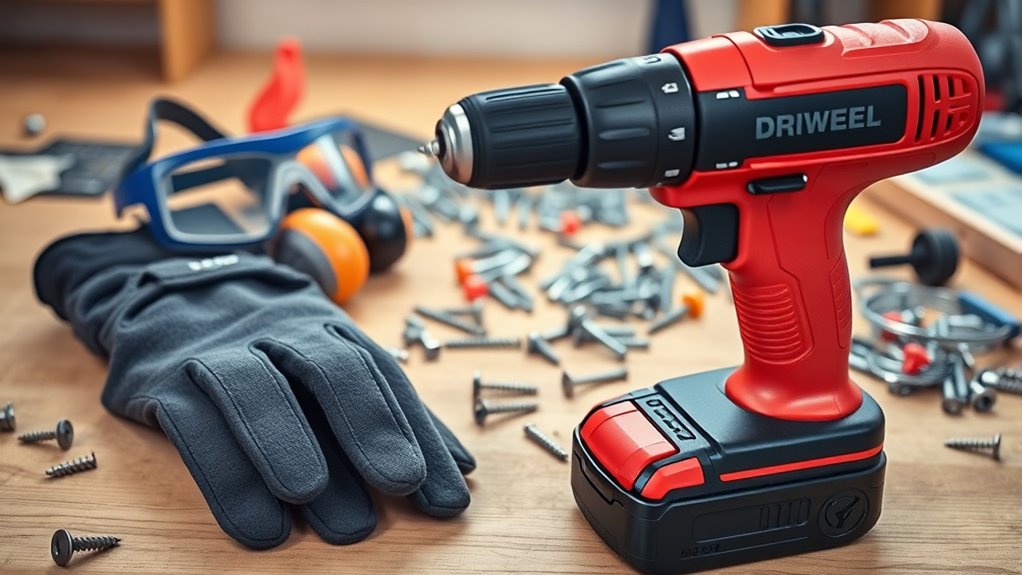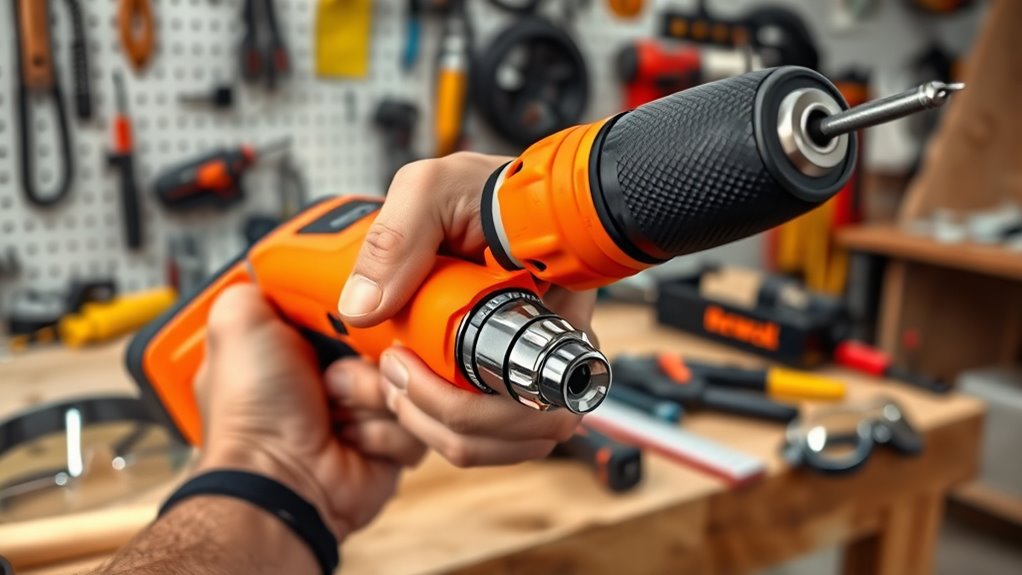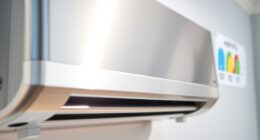To stay safe while using power tools, always wear the right protective gear like goggles, gloves, and ear protection. Keep loose clothing and jewelry away from moving parts, and never use tools without understanding how they work. Regularly inspect and maintain your equipment, and follow manufacturer instructions carefully. Keep your work area clean and well-lit, and never improvise with tools. Want to learn more essential safety tips to prevent accidents?
Key Takeaways
- Always wear appropriate personal protective equipment, including eye protection, gloves, and earplugs, when operating power tools.
- Read and follow manufacturer instructions thoroughly before using any power tool.
- Keep loose clothing, jewelry, and long hair away from moving parts to prevent entanglement.
- Regularly inspect and maintain tools to ensure they are in proper working condition.
- Keep your workspace clean, well-lit, and organized to reduce accidents and ensure safe tool operation.

Are you aware of the risks involved when using power tools? Every year, roughly 400,000 emergency room visits in the U.S. are linked to power tool injuries, including accidents during work and DIY projects. Power tools like table saws, nail guns, chainsaws, and drills are powerful but dangerous if mishandled. For instance, table saws alone cause about 29,000 ER visits annually, making them one of the most hazardous tools around. Nail guns contribute nearly 40,000 injuries each year, with a significant number affecting DIY users who might not fully understand proper safety procedures. Chainsaws lead to around 36,000 injuries yearly, often from improper handling or lack of protective gear. Power drills, while seemingly simple, cause about 5,800 injuries annually, mainly puncture wounds and electrical shocks.
Most injuries happen because of misuse or mishandling. Inexperienced users often overlook safety protocols, and even seasoned DIYers can become complacent, increasing their risk. Loose clothing or jewelry can get caught in moving parts, leading to severe accidents. Many injuries also stem from not using proper protective equipment, like safety glasses, gloves, ear protection, and sturdy work boots. Mechanical malfunctions, though less common, can contribute to injuries if tools are poorly maintained or defective. Regular inspection and proper maintenance of tools can help prevent Mechanical malfunctions. Overall, the primary causes are user errors, neglecting safety measures, and occasional mechanical failures.
The types of injuries vary but can be quite severe. Power saw accidents frequently result in cuts, amputations, and broken bones. Puncture wounds and electrocution are common with drills, especially if safety precautions aren’t followed closely. Nail guns can cause deep puncture injuries, sometimes severe because of the force involved. Long-term exposure to loud power tools can even damage your hearing, and flying debris from cutting or drilling can lead to eye injuries if you’re not wearing protective glasses.
To stay safe, always prioritize safety precautions. Use the right personal protective equipment—safety glasses, gloves, ear protection, and sturdy footwear are non-negotiable. Keep loose clothing and jewelry away from moving parts to prevent accidents. Make sure you understand how each tool works before you start, and never operate a power tool without proper training or knowledge. proper training and awareness significantly decrease the likelihood of accidents, especially when operating complex or powerful tools. Regularly inspect and maintain your tools to prevent malfunctions. Follow the manufacturer’s instructions and adhere to local safety regulations. Keep your work area clean, well-lit, and organized to avoid slips and trips.
Stay vigilant and alert throughout your project. Use tools only for their intended purposes, and never improvise. Disconnect power tools before changing blades or cleaning them. Store your tools safely, out of reach of children and unauthorized users. Remember, injuries are more common among men, but anyone, regardless of experience, can be hurt if safety isn’t a priority. Whether you’re a novice or an experienced DIYer, respecting these safety tips reduces your risk of injury and helps you complete your projects safely.
Frequently Asked Questions
How Should I Store Power Tools Safely When Not in Use?
When you’re not using your power tools, store them in a dry, well-ventilated area, keeping them off the ground on shelves or in cabinets. Remove batteries to prevent accidental activation and store them separately. Clean and inspect your tools before storing, repairing or replacing damaged parts. Use organized containers or wall mounts for easy access, and lock storage areas to keep your tools secure and protected from moisture, dust, and damage.
What Should I Do if a Power Tool Overheats?
When your power tool overheats, it’s like a volcano erupting inside—stop immediately to prevent disaster! Disconnect it from the power source, let it cool completely, and inspect for damage like smoke or strange smells. Avoid using it again until fully cooled. If it shows persistent abnormalities, don’t risk further damage—seek professional servicing. Always give your tools proper breaks and maintenance to avoid fiery mishaps!
Are There Specific Safety Gear Recommendations for Different Power Tools?
When working with different power tools, you should wear specific safety gear to stay protected. For cutting or grinding tools, always use safety goggles or a face shield to guard your eyes. Ear protection is essential for loud tools like saws or drills. Gloves help with grip and hand safety, especially during sanding. A dust mask keeps you safe from inhaling particles, and a hard hat is crucial if there’s a risk of falling objects nearby.
How Often Should Power Tools Be Inspected for Safety?
Imagine opening your toolbox each morning, feeling the weight of your power tools. You should inspect them daily with quick visual checks to catch any damage. Weekly, thoroughly examine safety guards and devices. For older or heavily used tools, increase inspection frequency, especially if you notice wear. Following manufacturer guidelines and considering how often you use the tools helps keep you safe and prevents unexpected failures during your projects.
What Are the First Steps if I Get an Electric Shock From a Tool?
If you get an electric shock from a tool, first, turn off the power source immediately to stop the current. Do not touch you or the tool directly if you’re still in contact; use a non-conductive object to disconnect the power. Once safe, check your breathing and responsiveness. Call emergency services if needed, and seek medical attention even if injuries seem minor. Always follow proper first aid procedures for electric shock.
Conclusion
Now that you know the essential safety tips, you’re ready to tackle your projects with confidence. But remember, even the most experienced DIYers can overlook small details. Will you stay vigilant and prioritize safety every time? The next cut, drill, or sanding could hold surprises—are you prepared to handle them safely? Keep your focus sharp, and don’t let complacency turn your skills into hazards. Your safety depends on it—are you ready for what’s next?









